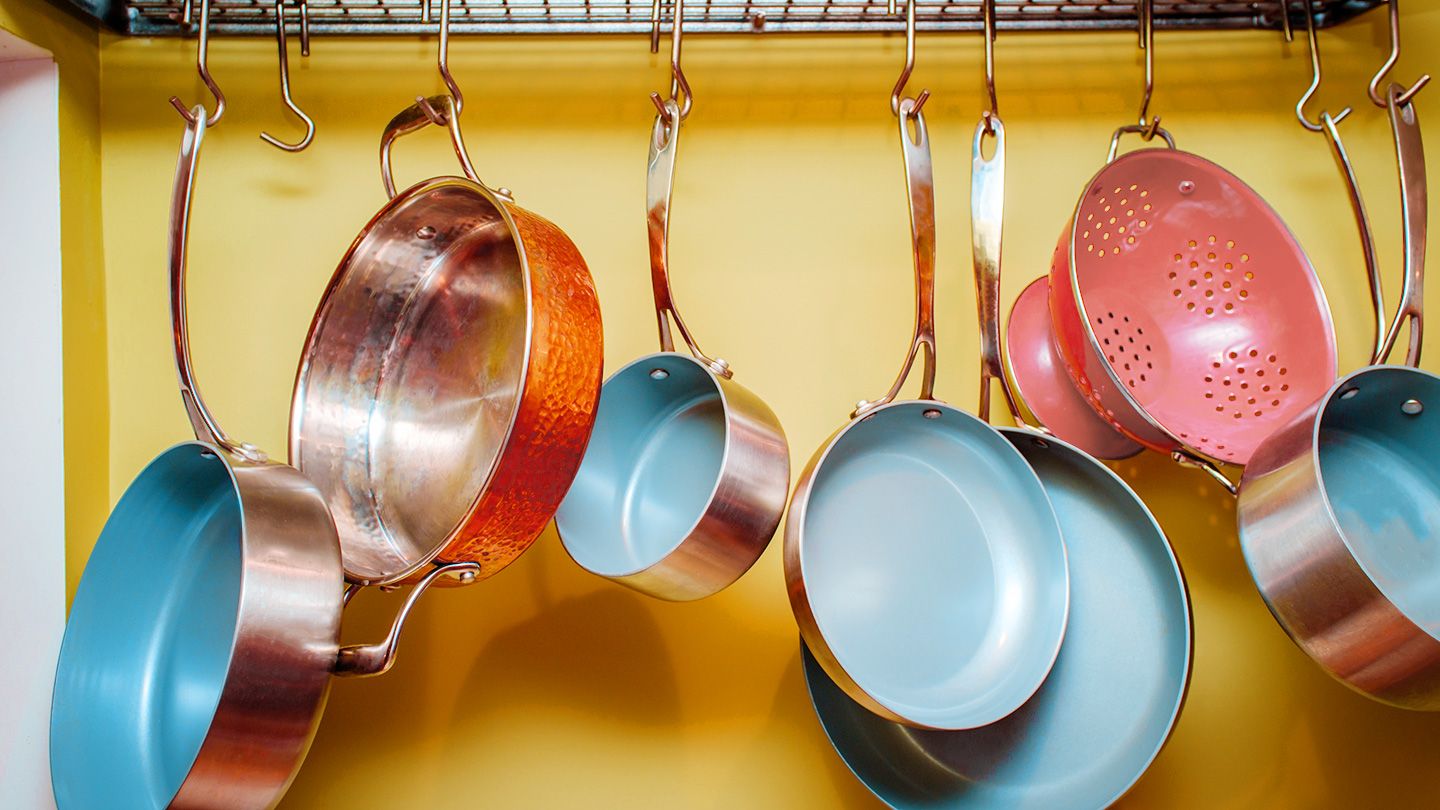You probably shop for nutritious food and search for healthy recipes, but the fact is, what your cookware is made of can also be important for your long-term health.
And nonstick cookware is not the only material that’s come under fire. Research suggests some other types of cookware (such as aluminum and copper) may contribute to various illnesses, says Linda Shiue, MD, director of culinary medicine at Kaiser Permanente in San Francisco. “Choosing cookware not only makes a difference in the experience of cooking but can also make a difference with regards to health,” she says.
Fortunately, you can reduce your risk of harm by choosing safer materials and following a few guidelines.
Why Choosing Safe Cookware Is Important
Being selective with cookware is essential because certain materials can create toxic fumes or leach toxins into food, says Raj Dasgupta, MD, a Los Angeles–based physician and medical reviewer for the National Coalition on Aging.
“While small amounts of metals like aluminum or chemicals like PFAS may not be harmful at first, the issue is that we’re exposed to them from so many sources,” Dr. Dasgupta says. Over time, these substances can accumulate in our bodies because we encounter them repeatedly through cookware, drinking water, and other everyday exposures. “This buildup can eventually lead to health problems, especially after years of exposure”, he says. “That’s why it’s important to pay attention to how much we’re exposed to in our daily lives.”
Safest Cookware Materials for Your Health
No cookware is perfect, but experts say some are safer than others. “The safest cookware materials in terms of the possible impact on health would be those that do not react with food or ingredients, do not release harmful chemicals, and are durable and easy to clean,” says Andrea De Vizcaya Ruiz, PhD, professor of environmental and occupational health at the University of California Irvine Joe C. Wen School of Population and Public Health. Dr. De Vizcaya Ruiz says cookware identified with the following labels may indicate that they are safer:
- PFOA-Free PFOA, or perfluorooctanoic acid, is a type of PFAS that has been identified as “carcinogenic to humans” by the International Agency for Research on Cancer. It was phased out of nonstick pans by 2016, but according to Consumer Reports, even cookware made without PFOA may still contain it because it can be a byproduct of other PFAS.
- PTFE-Free PTFE (polytetrafluoroethylene) was touted as a safer alternative to PFOA but evidence shows that may not be the case; to be on the safer side, look for cookware marked free of this chemical.
- Lead-Free Research has shown that aluminum, brass, and other metal cookware — particularly those that are manufactured in other countries and sold in the United States — are potentially significant sources of lead exposure.
- Cadmium-Free Cadmium is a heavy metal found in food, water, and the environment that’s been associated with health problems affecting the kidneys, heart, lung, and more, depending on the level and length of exposure. While cadmium in food is a common source of exposure, some pottery glazes contain cadmium, so one way to reduce your risk is to look for cookware that doesn’t contain the metal. Research has also shown that imported metal cookware contains high levels of cadmium.
- FDA-Approved Federal regulations say that a substance that comes into contact with food (which includes cookware) must be approved by the U.S. Food and Drug Administration (FDA) before it can be sold in the United States. This label indicates that the product has met FDA safety standards.
Glass
“Glass is inert and nontoxic,” she says. “However, one of the risks that glass cookware can present is when it is exposed to sudden temperature changes, which may cause it to crack or shatter.” Her tip: Look for products made with tempered or borosilicate glass, which are more resistant to heat.
Ceramic
Dr. Minich says leaching is more likely to occur when cooking acidic foods or for long periods. “The source and age of ceramics may also determine the risk of metal leaching,” she says. She suggests avoiding older products and choosing ceramic cookware that are labeled “lead-free.”
Cast Iron
Cast iron requires a little more TLC than some materials, but Minich says it’s safe — and potentially beneficial — for most people.
“Compared to other cookware that uses alloys, colors, paints, and glazes in processing, cast iron is made from nearly pure iron and is seasoned with oils,” Minich says. “Although some iron may leach into food, it is generally a small amount that will not affect the average person.”
In fact, she says, it’s been suggested that the iron leaching may be a desirable effect, and may be used as part of a strategy to help reduce the risk of anemia. “However, research is mixed, and more research is needed,” says Minich.
However, people with hemochromatosis (a condition that causes your body to absorb too much iron from food) may need to avoid cast iron, as it could cause excessive amounts of the metal to build up in the body, Minich says. Iron pans are more likely to leach if they are used to cook acidic foods, she adds.
Even if you don’t have hemochromatosis, it may be wise to periodically check your iron levels if you use cast iron cookware, just to be safe, says Elizabeth Bradley, MD, medical consultant at Dartmouth Hitchcock Medical Center and Clinics and medical director and owner of Advanced Functional Medicine and Longevity Center in Lyme, New Hampshire.
“If you are a lover of cast iron, just have your blood tested occasionally (to check iron levels) to ensure you’re not getting too much,” she says.
Stainless Steel
Stainless steel is another safe choice, though there is a slight risk of metal leaching, Minich says.
“Like cast iron, stainless steel may leach metals, such as nickel and chromium, into foods,” Minich says. “The best ways to prevent leaching are to avoid using stainless steel cookware when cooking for longer than 20 hours, cooking acidic foods, and cleaning with abrasive sponges.”
Cookware Materials to Possibly Reconsider
De Vizcaya Ruiz says the least safe cookware options are those that are likely to leak harmful substances, react with food, or degrade over time and with use. Experts recommend using the following sparingly, if at all.
Aluminum
“The intake of harmful toxic substances from the leakage of metals present in cookware has been linked to several health outcomes, such as neurological and reproductive disorders in the case of aluminum,” De Vizcaya Ruiz says.
Minich recommends avoiding cooking acidic foods in aluminum pots, pans, or foil to reduce the risk of leaching and using heat-stable parchment paper instead of aluminum foil. “Note that some pans may have a bottom surface made of aluminum,” she adds.
“A category I really like is hard-anodized, which can be made from any material, although most commonly done with aluminum pots and pans,” she says. “Anodizing means oxidizing the surface of a metal, which makes it more durable and easier to clean.”
Teflon
While PFOA was no longer used to make Teflon by 2016, Dr. Bradley says newer nonstick pans may have other PFAS. “Our research found many pans coated with PTFE are labeled as ‘PFOA-free’ and sometimes ‘PFOS-free,’ which are claims that may be misleading, even if they are technically true,” she says. “PFOA-free does not mean PFAS-free. In fact, a nonstick pan that says ‘PFOA-free’ but does not also say ‘PTFE-free’ or ‘PFAS-free’ likely contains PFAS.”
While some experts say newer nonstick coatings are perfectly safe when used properly, Minich advises exercising caution. “The safest route is to avoid Teflon and other nonstick pans,” Minich says.
Copper
Bradley doesn’t recommend using copper cookware because copper can leach into food. “We do need copper in our body. We get it through food and it’s a very small amount,” she says. “If we get too much copper, it actually displaces zinc (which is vital for immunity, growth, and development) and people can become zinc deficient if they have too much copper.”
Tips for Safely Using Cookware
Whatever type of cookware you use, following a few best practices can help you reduce the risk of toxin exposure.
Cook on Low Heat
Wash Carefully
It’s equally important to wash cookware according to the manufacturer’s recommendations to avoid damage and degradation, De Vizcaya Ruiz says.
Use Cooking Utensils That Won’t Scratch
“No matter what cookware you use, it’s equally important to use utensils that won’t damage the cooking surface,” Shiue says.
Store Properly
“Store cookware properly to avoid damage,” De Vizcaya Ruiz says. “Use protective padding between stacked items to prevent scratches and chips.”
When to Replace Cookware
Choosing safer materials is the best way to protect yourself and your family from potential health hazards, but you don’t have to replace all your pots and pans at once. Experts recommend doing regular inventory and tossing the following items:
When Products Are Old and Worn-Out
When Items Are Damaged
“Look for signs of wear, such as scratches, chips, rust, or warping. Replace cookware that shows significant damage,” De Vizcaya Ruiz says. Besides increasing the risk of toxin leaching, Shiue says cracks can pose other safety hazards. “Any other pan that has a visible crack should be avoided because it might break when heated, and could be a place where bacteria can breed,” she says.
The Takeaway
Choosing the right cookware is important for your and your family’s health. Although no materials are risk-free, some, such as cast iron, ceramic, glass, and stainless steel, are safer than others, including those with nonstick coatings. Whatever you’re cooking with, it’s also important to maintain and use your cookware according to manufacturer guidelines and discard items that are damaged or past their prime.



